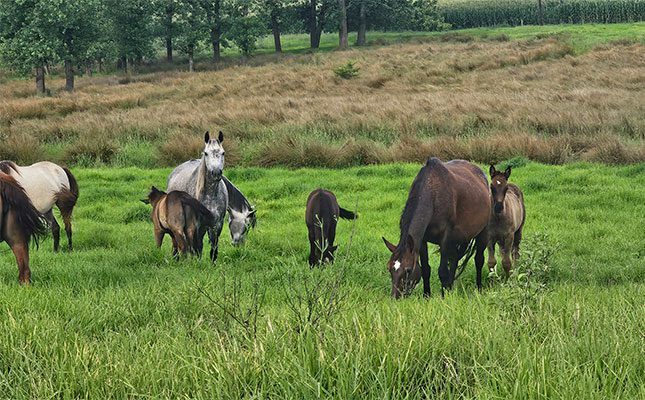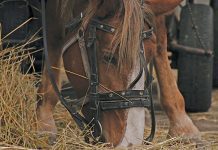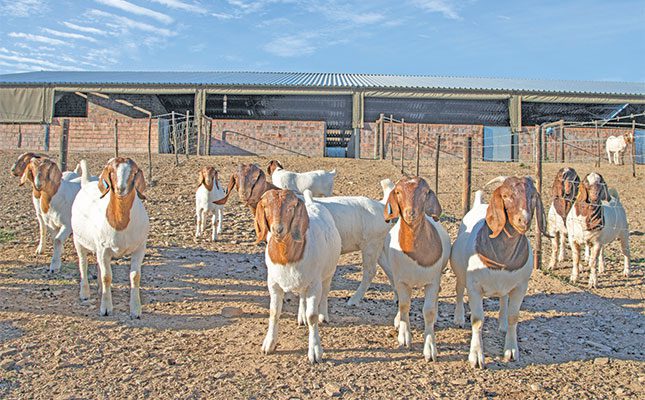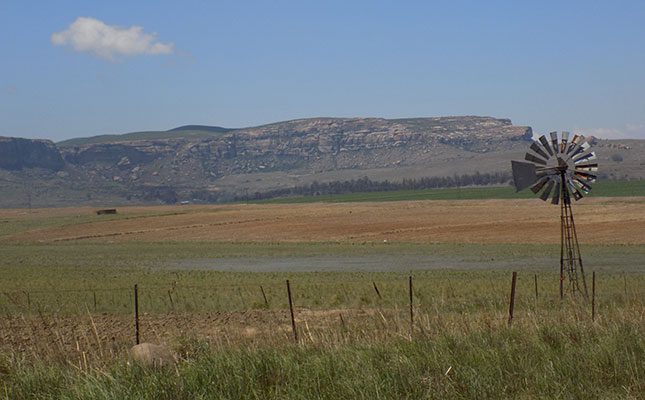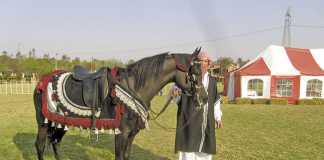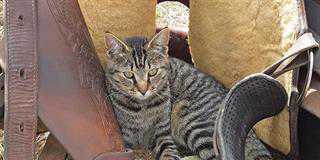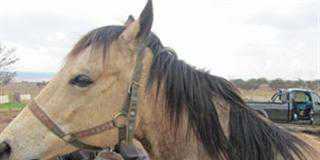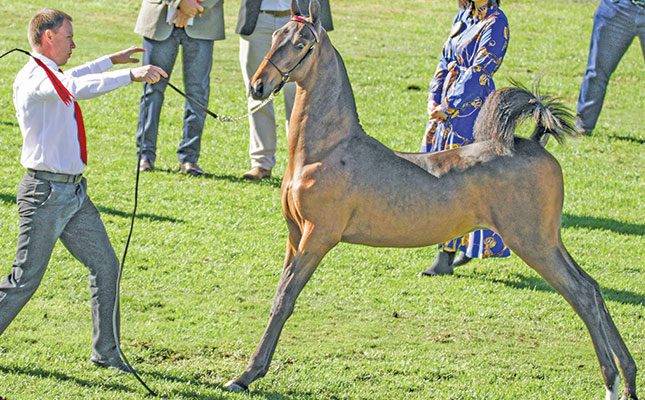
Photo: Adri Krige
How would you describe a Saddlebred horse in terms of the breed standard?
The American Saddlebred is known for its refined beauty, proud presence, and expressive movement. According to the breed standard, it is a harmonious blend of elegance, athleticism, and style.
It is a long-necked, high-headed horse with a naturally animated and graceful way of moving. It should appear alert, intelligent, and stylish, exuding presence and charisma, especially in motion.
Its height ranges from 15hh to 17hh, and it weighs between 450kg and 550kg.
Its head is refined and well-proportioned, with large, expressive eyes, a straight or slightly convex profile, and well-set ears that are small, alert, and positioned close together.
The neck is long, arched, and fine, and set high on its shoulders, giving the horse its distinctive upright head carriage. The neck is smoothly joined at the throatlatch.
It has a deep chest and well-sprung ribs. It has a short, strong back, a level topline and well-muscled hindquarters. Its tail is naturally long and should be set high and carried proudly. Its legs are clean and straight, with strong bones. Joints are well-defined, with sloping pasterns for shock absorption. Hooves are strong and sound.
The hallmark of the breed, however, is its movement. The Saddlebred moves with an animated, high-stepping trot; a graceful, cadenced canter; and, in gaited horses, optional lateral gaits. Both the slow gait and rack are smooth, flashy, and performed with style and precision.
The Saddlebred is intelligent, willing, and people-oriented. It is bold and energetic yet manageable, making it suitable for both amateur and professional riders. It is also known for its desire to perform and its natural aptitude for training.
Please tell us more about the history of the Saddlebred as a breed.
The Saddlebred stems back to the 1600s, originating from ‘easy-gaited’ Galloway and Hobbie horses brought to North America from the British Isles. These were foundation stock for the Narragansett Pacer, one of America’s earliest recognised horse types. It was bred primarily in Rhode Island and Virginia, and was famous for its smooth, lateral gait, ideal for long-distance travel and comfort in the saddle.
The now extinct Narragansett was bred to Thoroughbreds imported from England in the early 1700s, resulting in a new type of riding horse known as the American Horse. It combined the refinement of the Thoroughbred with the smooth gaits and gentle temperament prized by colonial riders. These were all-purpose horses, serving in battle, ploughing fields, pulling carriages, and offering comfortable transport.
Most notably, it was the American Horse that carried colonial cavalrymen to victory at the Battle of King’s Mountain in South Carolina. After the war, settlers took these animals through the Cumberland Gap into Kentucky, where further development continued.
Over time, breeders introduced more Thoroughbred blood, as well as Morgan and Standardbred influence, refining the type into what would become the American Saddlebred.
By the early 1800s, Saddlebreds were dominating show circuits in Kentucky, Virginia, and Missouri, praised for their elegance, athleticism, and versatility. In 1856, they took centre stage at America’s first national horse show in St Louis.
Kentucky quickly emerged as the breed’s stronghold, and ‘Kentucky Saddlers’ gained a national reputation.
During the American Civil War, Saddlebreds were valued by Confederate cavalry for their endurance and calm under pressure, carrying soldiers through long campaigns.
After the war, the Saddlebred spread across the country, appearing on the bridle paths of New York and the cattle ranges of Texas.
Today, the breed is found in all 50 US states and around the globe, including Canada, Europe, and notably South Africa.
What is the history of the breed in South Africa?
The American Saddlebred was introduced to South Africa shortly after World War I, when a small group of breeders and enthusiasts began importing horses to enhance local equine stock.
Local farmers and horsemen were drawn to the Saddlebred’s elegance, intelligence, and comfortable gaits, particularly the ability to perform the five gaits (walk, trot, canter, slow gait, rack), which made it especially suited to both show and utility purposes.
Through the mid-20th century, interest in Saddlebreds steadily increased, with growing numbers imported from the US. The breed’s high-stepping action and flashy presence made it a favourite in the show ring, where South African horse shows began to adopt American-style saddle seat competitions.
Breeders worked to establish strong bloodlines and adapted the breed to local conditions without compromising distinctive qualities.
In 1973, the Saddlebred Society of South Africa was established to formally register, promote, and maintain the breed standard. This allowed for a structured breeding programme and the development of a distinct SA Saddlebred identity, closely aligned with the American breed standard but with unique local influences.
The society began hosting national championship shows and inspections, raising the profile and prestige of the breed. It also developed close ties with American Saddlebred organisations, fostering the exchange of breeding stock and expertise. Many South African horses competed successfully internationally, helping to enhance the breed’s global reputation.
Today, the American Saddlebred is the most popular non-racing breed in South Africa. The country boasts a vibrant show scene, active breeding community, and a strong export market, with South African horses regularly performing at elite levels both at home and abroad.
The breed continues to thrive thanks to a committed network of breeders, trainers, and riders who value its style, stamina, and spirit. In South Africa, as in the US, the American Saddlebred remains a breed of beauty and brilliance, symbolising grace in motion.
What are the society’s main goals when it comes to the ongoing development and/or preservation of the breed?
The society is dedicated to the continual advancement and preservation of the American Saddlebred within the South African context. Its mission is to maintain the breed’s unique identity while adapting to evolving equestrian demands, ensuring the Saddlebred remains a versatile, sound, and show-stopping athlete for future generations.
The society’s goals are centred on these following core priorities:
- Preservation of breed type and standard
A primary objective is to safeguard defining characteristics of the Saddlebred – its refined conformation, proud head carriage, natural elegance, and expressive, animated movement.
The society maintains strict breed standards to ensure each generation continues to reflect the distinctive identity of the Saddlebred, both in form and in function. - Promotion of soundness and structural integrity
Soundness is a cornerstone of sustainable breeding. The society encourages selection for correct conformation and durability, ensuring that horses can perform comfortably and consistently throughout their careers. Attention to strong bones, clean limbs, and correct gait mechanics is essential to breeding horses that are both beautiful and functional. - Focus on temperament and trainability
A hallmark of the Saddlebred is its kind, intelligent, and willing nature. The society emphasises the importance of temperament in breeding programmes, promoting horses that are eager to work, responsive to training, and suitable for a wide range of riders, from professionals to amateurs and the youth. A manageable yet spirited disposition is a valued trait. - Refinement of gait and performance
One of the breed’s most celebrated attributes is its unique way of going, especially the precision and brilliance of the five gaits. The society aims to refine and enhance gait quality, ensuring rhythmic, expressive, and biomechanically sound movement. High action and style must be paired with correct timing and natural athleticism. - Genetic diversity and long-term viability
Sustainable breeding requires careful genetic management. The society supports practices that promote genetic diversity while preserving the best attributes of established bloodlines. Through selective imports and local breeding excellence, it strives to build a strong, adaptable, and resilient Saddlebred population. - Education and youth development
Recognising that the future of the breed lies in the hands of the next generation, the society actively supports youth involvement and breeder education. Through clinics, shows, and mentorship programmes, it cultivates a new wave of knowledgeable, passionate Saddlebred enthusiasts. - International collaboration and recognition
The society works to uphold and elevate the global reputation of the SA Saddlebred. By aligning with international standards and participating in global events, it ensures that South African-bred horses remain competitive, admired, and influential on the world stage.
To which disciplines is the Saddlebred best suited?
The American Saddlebred is one of the most versatile and trainable horse breeds, with a natural flair and willingness that makes it excel in a wide range of equestrian disciplines.
While it is most famously associated with saddle seat showing, its athleticism, smooth gaits, and intelligence lend it to several other competitive and recreational activities. Here’s where the Saddlebred truly shines:
- Saddle seat
This is the signature discipline for the American Saddlebred. The breed’s high-headed carriage, animated movement, and stylish presence make it ideal for three-gaited classes (walk, trot, canter), and five-gaited classes (including the slow gait and rack). - Driving
Saddlebreds are natural show-stoppers in fine harness and pleasure driving. Their animated action, arched necks, and forward energy make them eye-catching and competitive in front of a cart. Their natural cadence and responsiveness also suit them well to combined driving events at the amateur level. - Dressage
While not traditionally associated with classical dressage, some Saddlebreds perform exceptionally well in lower to mid-level dressage, particularly due to their trainability, forward movement, and eagerness to work. Crosses like the Saddlebred-Warmblood are becoming more common in this discipline. - Trail and endurance riding
Smooth gaits, stamina, and a bold, curious nature mean Saddlebreds are often used in trail riding, endurance competitions or pleasure hacking. Their comfortable way of going and mental toughness make them great long-distance or recreational riding partners. - Eventing and jumping (light)
Although not bred specifically for jumping, some Saddlebreds, particularly those with more sport-horse type conformation, can do well in eventing (especially in lower levels), show jumping or hunt seat equitation. Their agility, bravery, and willingness can make them enjoyable, if unconventional, partners in these disciplines. - Western and ranch-type events
In recent years, some Saddlebreds have also been successfully introduced to Western pleasure, ranch riding and working equitation. Their adaptability and people-oriented temperament allow them to transition into disciplines that demand obedience, responsiveness, and smooth movement. - Therapeutic riding and youth programmes
Thanks to their gentle, intuitive nature, Saddlebreds are increasingly used in therapeutic riding and youth programmes. They are generally tolerant, affectionate, and sensitive to riders’ cues, making them ideal for building confidence and connection.
Where does it excel?
- Performance and show-ring presence: the Saddlebred is unparalleled in saddle seat disciplines.
- Trainability and temperament: they are highly intelligent, responsive, and people-oriented.
- Versatility: whether in harness, under saddle, or out on the trail, they adapt to many roles.
- Longevity and endurance: known for staying sound and spirited well into their senior years.
How do SA Saddlebreds compare with those elsewhere in the world?
One of the most significant milestones came in 1997, when a South African-bred five-gaited stallion won the World’s Grand Championship at the Kentucky State Fair, one of the most prestigious titles in the Saddlebred world. This historic win not only showcased the quality of South African breeding programmes but also validated decades of careful development and dedication.
Today, SA Saddlebred horses are widely recognised for their distinctive style, bold action, and exceptional presence, and they compare very favourably to Saddlebreds in other parts of the world, particularly the US, where the breed originated.
SA Saddlebreds generally adhere closely to the traditional American breed standard, which is refined, high-headed, with a long, arched neck, expressive face, and balanced proportions.
However, South African breeding has also placed particular emphasis on strong toplines and hindquarters for power and endurance; clean, straight legs and soundness, which are essential for long-term performance; and good bones and hard hooves, well-suited to the country’s varied terrain.
In summary, SA Saddlebreds stand shoulder to shoulder with the best in the world. They are admired for their beauty, movement, and charisma, and respected for their soundness, spirit, and show-ring performance. The SA Saddlebred has evolved into a distinct yet globally competitive version of the breed that continues to gain admiration and recognition on the international stage.
Tell us more about the Nationals and why this event is significant.
The SA Saddlebred Nationals, held annually in Bloemfontein, is one of the most significant events on the global Saddlebred calendar, and proudly regarded as the largest open-air Saddlebred championship in the world.
The Nationals represent the pinnacle of Saddlebred competition in South Africa, drawing the top horses, riders, breeders, and trainers from across the country. It’s where the very best compete across divisions – three-gaited, five-gaited, in-hand, driving, junior, amateur, and open classes.
Winning a title in Bloemfontein is considered one of the highest honours in the SA Saddlebred world, with strong reputational and breeding value. Its reputation extends far beyond South Africa. Top international judges are often invited to officiate, adding global credibility, while international breeders and enthusiasts attend or follow the show closely.
Horses that excel at the Nationals often attract export interest or go on to compete abroad, particularly in the US and Europe. This event places South Africa firmly on the map as a global leader in Saddlebred breeding and competition.
The open-air setting, large spectator turnout, and electric atmosphere give the Nationals a distinct flavour. The venue at the Bloemfontein Showgrounds allows for large entries, vibrant crowds, and a festive ambiance. The event reflects the community spirit and passion of South African breeders and horse lovers.
The Nationals serve as an informal benchmark for breeding success. Top-performing horses often influence future breeding trends, and youngstock classes provide a glimpse into the next generation of champions. Sales and networking opportunities during the event contribute to the economic engine of the Saddlebred industry.
The show also plays a vital role in developing young talent, with strong participation in junior and amateur classes. It’s an opportunity for future champions and industry leaders to cut their teeth and gain national exposure.
For more information email [email protected].


